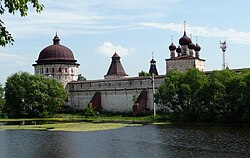Borisoglebsky on the Usta Rostavsky Monastery - male Orthodox monastery on the road from Rostov to Uglich (in the village of Borisoglebsky ), part of the " Golden Ring of Russia ". The architectural complex of the monastery was fully formed during the pre-Petrine era , when it was one of the richest in the Rostov metropolis , and among the Moscow princes and the first Russian tsars was considered “domestic” [1] . After the 17th century, the architectural ensemble remained almost unchanged.
| Monastery | |
| Rostov Borisoglebsky Monastery | |
|---|---|
 | |
| A country | |
| Village | Borisoglebsky (Yaroslavl region) |
| Denomination | Orthodoxy |
| Diocese | Yaroslavl and Rostov |
| Type of | Male |
| Founding date | 1363 year |
| Key Dates | |
| 1924 - abolished 1994 - reborn | |
| Building | |
| The Cathedral of Boris and Gleb • The Church of the Annunciation with the refectory chamber • Sergievskaya Gate Church • Walls and towers | |
| Famous nuns | Irinarkh Rostov Tikhon (Malyshkin) Amphilochius (Sergievsky-Kazantsev) |
| Status | |
| Site | ikh.rf |
Content
Monastery history
It was founded by the monk Theodore, who had come from the Novgorod land, and Paul who joined him later [2] with the blessing of Sergius of Radonezh in 1363 [3] . According to the "Tale of the Borisoglebsky Monastery" [4] , Sergius of Radonezh himself chose a place for the monastery. The founders of the monastery are glorified as reverend and enter the Cathedral of Rostov-Yaroslavl saints . Their burial is located in the northwestern corner of Boris and Gleb Cathedral and serves as a venue for the veneration of these saints.
Rev. Irinarkh the Recluse , who lived in the monastery at the end of the 16th and the beginning of the 17th centuries, was especially famous; his relics are secretly stored in the churchyard of the cathedral’s monastery. According to the life of the saint, Prince Dmitry Pozharsky [5] and Nizhny Novgorod townsman Kuzma Minin received a blessing in defense of Moscow from the Poles in 1612 .
Among the church leaders who labored in the Rostov Borisoglebsky Monastery were the Archbishop of Rostov and Yaroslavl Tikhon (Malyshkin) . The abbot of the monastery in New Time for some time was a famous archeographer and paleographer, collector and explorer of the monuments of Old Russian literature Amphilochius , the future Bishop of Uglich.
The monastery became the spiritual and economic center around which the Borisoglebsk settlements appeared - a large trading village in the Rostov district of the Yaroslavl province , the center of the Borisoglebsk volost . In 1764, the suburbs from the possession of the monastery were transferred by Catherine II to her favorite Count G. G. Orlov . On the feast of Boris and Gleb , a rich fair was traditionally held near the walls of the monastery.
In 1924, the monastery was officially abolished. In the Soviet period, various institutions of the district center were located in the monastery buildings - a post office, a state bank branch, warehouses of organizations for harvesting flax and grain.
Worship in the temples of the already abolished monastery continued until October 1928. On November 8, 1928, a museum of local lore (a branch of the Rostov Museum-Reserve ) was opened in the premises of the former monastery. It was closed by the order of the Yaroslavl Department of Culture dated February 8, 1954. The local history asset of the Borisoglebsky village was united, and the result was a national museum formed on September 29, 1961. This museum later became again a branch of the Rostov Museum-Reserve; it maintains such status at present.
Since 1994, the museum has shared premises with a revived monastery until 2015, when all property was returned to the latter. The buildings of the monastery as components of a significant monument of history and culture [6] are under state protection.
The modern look of the cloister
On the territory of the monastery are:
- the Cathedral of Boris and Gleb (1522-1523),
- Church of the Annunciation with the refectory chamber (1524–1526),
- Sergiev Gate Church (1679),
- belfry with the church of sv. John the Baptist (1690),
- Irinarch the Recluse's cell, etc.
Church of the Candlemas (1692)
Gate Church in 1911. Photo by Sergey Prokudin-Gorsky
Church of St. Sergius of Radonezh (1679)
Borisoglebsky Cathedral (1522–1523)
Cathedral Paintings (1911)
The belfry of 1690
The beginning of the Irinarkhov procession in 2014
Notes
- ↑ Rostov the Great. State Museum-Reserve "Rostov Kremlin" (Not available link) . The date of circulation is March 6, 2008. Archived January 23, 2008.
- ↑ Zdravomyslov K. Ya. Theodore (Rev., Founder and Hegumen of the Rostov-based Borisoglebsky Monastery) // Russian Biographical Dictionary : in 25 volumes. - SPb. - M. , 1896-1918.
- ↑ Memory of St. Theodore and Paul of Rostov, the founders of the Borisoglebsky Monastery (inaccessible link)
- ↑ The Tale of the Borisoglebsky Monastery from colic years and how it began
- ↑ In the settlement of Borisoglebsky opened a boiler room and a monument to Dmitry Pozharsky
- ↑ Ensemble of Borisoglebsky Monastery
Links
Literature
- Melnik L. Yu. To the History of the Borisoglebsky Museum // Reports of the Rostov Museum. Issue 1. - Rostov, 1991. - p. 120-131.
- Miller A. G. On the belfry of the Borisoglebsky monastery // Bells and the belfry of Rostov the Great. Messages Rostov Museum. Issue 7. - Yaroslavl, 1995. - P. 215-226.
- Melnik L. Yu. The history of the bells of the Borisoglebsky Monastery // Reports of the Rostov Museum. Issue 7. - Yaroslavl, 1995. - p. 227-238.
- Melnik A.G. Interior of the Forerunner Church of the Rostov Borisoglebsky Monastery // Monasteries in the life of Russia. - Kaluga; Borovsk, 1997. - P. 145-149, 277-278.